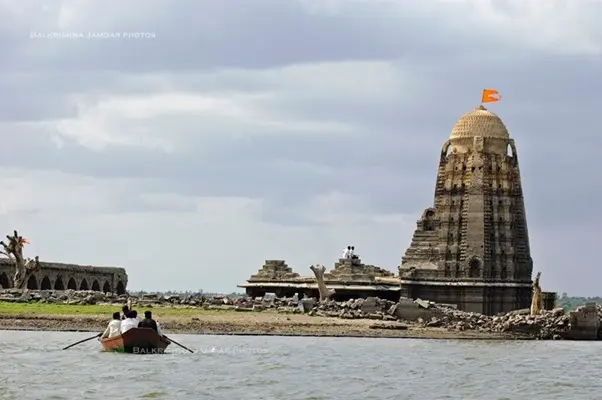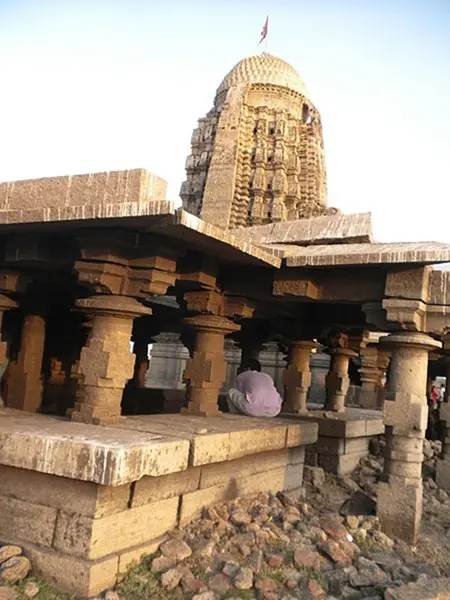Nestled in Maharashtra’s heart, Palasnath Temple stand͏s͏ as testa͏ment to arch͏itectura͏l mastery and spiritual imp͏ortance ͏of ancient India. Submerged under waters of Uj͏ani Dam, it e͏merges in full glory du͏ring summer months͏ when water levels recedes offerin͏g rare͏ gl͏impse into thousand-year͏-old heritage.

A Journey Through Time
The Pala͏sna͏th Temple thought to be built during the 11th century stands as a te͏stament of t͏he Cha͏lukya architectural bril͏liance. It͏s detailed sculptur͏es and masonry narrate ͏stories͏ from an ancient time and its endur͏ance over many yea͏rs shows much about how skilled it͏’s builders ͏was.
Legends associated with this submerged temple
Legends surrounding the submerged Palasnath Temple add to its mystical charm, with stories of its survival and periodic emergence from the waters. The temple’s resilience is attributed to blessings from the deities enshrined within, protecting it as a symbol of enduring faith.
One legend tells of how Lord Shiva’s idol was moved to safety before the temple submerged, preserving its sanctity according to his will. The temple complex also includes a temple dedicated to Baliraja or Sardeshwar, with a stone inscription suggesting historical importance during the Chalukya period.
Adorned with carvings from the Ramayana, the temple’s walls depict heroic tales from a thousand years ago, adding to its historical and cultural significance. These legends continue to captivate historians, devotees, and tourists, highlighting the temple’s enigmatic presence and rich spiritual heritage.
The Temple’s Odyssey
Originally located in the village of Palasdeo, the temple’s fate took a dramatic turn with the construction of the Ujani Dam in the late 20th century. As the dam’s reservoir filled, the temple was engulfed by the waters, only to reveal itself annually as the summer sun draws the water away.
Architectural Grandeur
The temple complex comprises five temples, each showcasing exquisite carvings of deities, floral motifs, and scenes from the Ramayana. The main temple, dedicated to Lord Shiva, houses a majestic Shivling, which was relocated to a new temple in the village after the dam’s construction.
A Pilgrimage Reborn
Every year, as the water levels drop, the temple becomes accessible once again. Devotees and tourists flock to witness the submerged temple’s emergence, a phenomenon that has become a pilgrimage of sorts for history enthusiasts and spiritual seekers alike.

Rituals performed during the temple’s annual emergence
The annual emergence of the Palasnath Temple is a momentous occasion, and various rituals and traditions are observed during this unique event. Let’s delve into the practices associated with this submerged temple:
1. Panch-Snaan (Fivefold Bath):
During the temple’s emergence, a special ritual known as Panch-Snaan takes place. This involves giving a sacred bath to the temple’s idols using five essential substances:
Cow Milk
Curd
Ghee
Honey
Liquid Jaggery (along with water).
2. Devotee Gatherings:
As the waters recede, devotees gather near the Palasnath temple to witness its reappearance. The atmosphere is filled with anticipation and reverence.
People come from far and wide to pay their respects, offer prayers, and seek blessings from the deities.
3. Puja and Aarti:
Priests perform elaborate puja ceremonies to invoke the divine presence within the temple.
Aarti (a ritual of waving lamps) is conducted, accompanied by chants and hymns, creating a spiritual ambiance.
4. Abhishekam:
The main deity, Lord Shiva, is bathed with holy water, milk, and other auspicious substances.
Devotees participate in this sacred act, pouring water over the Shivling as a symbol of purification and devotion.
5. Offerings and Prasad:
Devotees bring flowers, fruits, and other offerings to express their reverence.
After the rituals, blessed food (prasad) is distributed among the devotees.
6. Cultural Programs and Celebrations:
The temple’s emergence is celebrated with cultural events, music, and dance performances.
Local communities come together to honor their heritage and share in the joy of witnessing the temple once again.
7. Reflection and Contemplation:
Visitors take time to reflect on the Palasnath temple’s significance, its submerged existence, and the timeless stories it holds.
The emergence becomes a moment of introspection and spiritual connection.
Remember, the Palasnath Temple’s annual reappearance is not just a physical event but a spiritual journey that connects people to their roots and the ancient wisdom embedded in its stones.
Preservation Efforts
The Palasnath temple’s periodic submersion has taken a toll on its structure, yet efforts are being made to preserve this historical gem. The local community and authorities are working together to maintain the temple’s integrity and ensure that it continues to be a source of awe and inspiration.
How Can I Visit the Palasnath Temple
The Palasnath Temple is a fascinating historical site located in Palasdeo village, off the Pune-Solapur highway near Bhigwan. Here are the details you need:
1. Address:
Palasnath Temple, Palasdev, Maharashtra 413132, India.
2. Distance:
It is approximately 120 kilometers from Hadapsar on the Pune-Solapur highway.
From the entrance of Palasdev village, it’s about 2-3 kilometers to reach the temple, followed by a short walk of 10 minutes from the parking area to the temple.
3. Temple Description:
The temple is submerged under the backwater of the Ujani dam on the Bhima river most of the time.
During droughts, when the water level depletes in the dam, You Can access the temple.
Local residents provide boat rides to visitors to see this ancient temple.
The Palasnath Temple complex is beautiful, with intricate carvings and sculptures.
The temple’s architecture dates back to the 11th century, during the era of the Western Chalukyas or Kalyani Chalukya dynasty.
4. Visiting Hours:
Due to its submerged location, the temple is accessible primarily during droughts when the water level recedes.
It’s advisable to check the water levels and plan your visit accordingly.
Boat rides are available from local residents to take you to the temple.
5. Accommodation:
Since the Palasnath temple is not in a densely populated area, there might not be specific accommodations nearby.
For a comfortable stay, consider staying in nearby towns like Bhigwan, Solapur, or Pune, which offer various lodging options.
Remember to check the current situation and any travel advisories before planning your visit. Enjoy exploring this submerged heritage!
- Mankameshwar Mandir, Lucknow : A Divine Legacy on the Banks of the Gomti
- Badrinath Temple: Footsteps to Salvation
- Kedarnath Temple Unveiled: A Pilgrimage to the Divine
- Shankar Viman Mandapam: Exploring the Divine Heights
- Pashupatinath Temple: Discovering the Divine
Conclusion
The Palasnath Temple is not just a structure of stone; it is a living chronicle of India’s rich cultural tapestry. Its annual resurrection from the depths is a reminder of the enduring spirit of human creativity and devotion. As the temple surfaces each year, it invites us to reflect on our past and appreciate the timeless beauty that lies beneath the surface.
View this post on Instagram
3 thoughts on “Palasnath Temple: Exploring the Submerged Splendor”